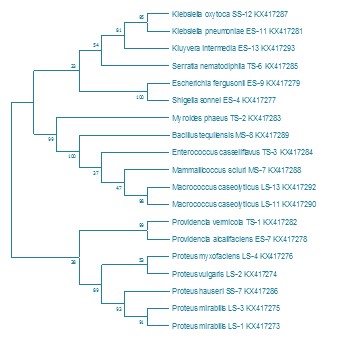
Analysis of bacterial diversity associated with commercial broiler chicken in Lahore, Pakistan
Abstract
Keywords
Full Text:
PDFReferences
Abdulwahid, A. and J. Zhao, 2022. China as a center of origin and domestication of chicken: A review. Agricultural reviews, 43(2): 170-177.
Ahmed, T., H. A. Ameer and S. Javed, 2021. Pakistan’s backyard poultry farming initiative: Impact analysis from a public health perspective. Tropical animal health production, 53(2): 1-12.
Assoumy, M. A., A. P. Bedekelabou, A. Teko-Agbo, W. Ossebi, K. Akoda, F. Nimbona, S. H. Zeba, A. A. Zobo, R. C. Tiecoura and V. Kallo, 2021. Antibiotic resistance of Escherichia coli and Salmonella spp. Strains isolated from healthy poultry farms in the Districts of Abidjan and Agnibilékrou (côte d’ivoire). Veterinary world, 14(4): 1020.
Bhattacharyya, S. and C. Das, 2022. Foodborne infections and food safety. Eastern journal of medical sciences.
Blake, D. P., V. Vrba, D. Xia, I. D. Jatau, S. Spiro, M. J. Nolan, G. Underwood and F. M. Tomley, 2021. Genetic and biological characterisation of three cryptic eimeria operational taxonomic units that infect chickens (Gallus gallus domesticus). International journal for parasitology, 51(8): 621-634.
Boubendir, S., J. Arsenault, S. Quessy, A. Thibodeau, P. Fravalo, W. P. Theriault, S. Fournaise and M.-L. Gaucher, 2021. Salmonella contamination of broiler chicken carcasses at critical steps of the slaughter process and in the environment of two slaughter plants: Prevalence, genetic profiles, and association with the final carcass status. Journal of food protection, 84(2): 321-332.
Clavijo, V. and M. J. V. Flórez, 2018. The gastrointestinal microbiome and its association with the control of pathogens in broiler chicken production: A review. Poultry science, 97(3): 1006-1021.
Felsenstein, J., 1985. Confidence limits on phylogenies: An approach using the bootstrap. Evolution, 39(4): 783-791.
Gichure, J. N., P. M. K. Njage, J. M. Wambui, G. A. Dykes, E. M. Buys and R. Coorey, 2022. Systematic-review and meta-analysis on effect of decontamination interventions on prevalence and concentration of Campylobacter spp. During primary processing of broiler chickens. Food microbiology, 102: 103923.
Hamed, E. A., M. F. Abdelaty, H. K. Sorour, H. Roshdy, M. A. A. AbdelRahman, O. Magdy, W. A. Ibrahim, A. Sayed, H. Mohamed and M. I. Youssef, 2021. Monitoring of antimicrobial susceptibility of bacteria isolated from poultry farms from 2014 to 2018. Veterinary medicine international, 2021.
Henchion, M., A. Moloney, J. Hyland, J. Zimmermann and S. McCarthy, 2021. Trends for meat, milk and egg consumption for the next decades and the role played by livestock systems in the global production of proteins. Animal, 15: 100287.
Lee, H. and Y. Yoon, 2021. Etiological agents implicated in foodborne illness world wide. Food science of animal resources, 41(1): 1.
Libera, K., K. Konieczny, J. Grabska, W. Szopka, A. Augustyniak and M. Pomorska-Mól, 2022. Selected livestock-associated zoonoses as a growing challenge for public health. Infectious disease reports, 14(1): 63-81.
Maharjan, P., D. Martinez, J. Weil, N. Suesuttajit, C. Umberson, G. Mullenix, K. Hilton, A. Beitia and C. Coon, 2021. Physiological growth trend of current meat broilers and dietary protein and energy management approaches for sustainable broiler production. Animal: 100284.
Marmion, M., M. Ferone, P. Whyte and A. Scannell, 2021. The changing microbiome of poultry meat; from farm to fridge. Food microbiology, 99: 103823.
Memon, M., K. Khan, A. Parvez, S. Shaikh, K. Khan, G. Xiangyu, M. Nasrullah and S. Liaqat, 2021. Economic viability of poultry farmers in pakistan: A case study of district mardan, Khyber Pakhtunkhwa. Journal of innovate science, 7: 142-151.
Miller, D. D. and C. Yeung, 2022. Food chemistry: A laboratory manual. John Wiley & Sons.
Rashid, Z., M. Z. Yousaf, S. M. H. Gilani, S. Zehra, A. Ali, A. Azhar and S. Galani, 2021. Comparative analysis of chicken cecal microbial diversity and taxonomic composition in response to dietary variation using 16s rrna amplicon sequencing. Molecular biology reports, 48(11): 7203-7214.
Tamura, K., G. Stecher and S. Kumar, 2021. Mega11: Molecular evolutionary genetics analysis version 11. Molecular biology evolution, 38(7): 3022-3027.
Wickramasuriya, S. S., I. Park, K. Lee, Y. Lee, W. H. Kim, H. Nam and H. S. Lillehoj, 2022. Role of physiology, immunity, microbiota, and infectious diseases in the gut health of poultry. Vaccines, 10(2): 172.
Zmora, N., J. Suez and E. Elinav, 2019. You are what you eat:
Diet, health and the gut microbiota. Nature reviews gastroenterology hepatology, 16(1): 35-56.
DOI: https://doi.org/10.33865/wjb.007.02.0540
Refbacks
- There are currently no refbacks.
Copyright (c) 2022 Farhana Azam, Sana Tanveer, Basharat Ali

This work is licensed under a Creative Commons Attribution 4.0 International License.
Print ISSN: 2522-6746 : Online ISSN: 2522-67541. How to register 2. How to reset password2. How to prepare a manuscript before submission 3. How to submit a paper 4. How to check the review status of a paper5. How to check the plagirisim or similarity report